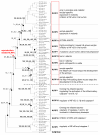Evolution and functional divergence of NLRP genes in mammalian reproductive systems
- PMID: 19682372
- PMCID: PMC2735741
- DOI: 10.1186/1471-2148-9-202
Evolution and functional divergence of NLRP genes in mammalian reproductive systems
Abstract
Background: NLRPs (Nucleotide-binding oligomerization domain, Leucine rich Repeat and Pyrin domain containing Proteins) are members of NLR (Nod-like receptors) protein family. Recent researches have shown that NLRP genes play important roles in both mammalian innate immune system and reproductive system. Several of NLRP genes were shown to be specifically expressed in the oocyte in mammals. The aim of the present work was to study how these genes evolved and diverged after their duplication, as well as whether natural selection played a role during their evolution.
Results: By using in silico methods, we have evaluated the evolution and functional divergence of NLRP genes, in particular of mouse reproduction-related Nlrp genes. We found that (1) major NLRP genes have been duplicated before the divergence of mammals, with certain lineage-specific duplications in primates (NLRP7 and 11) and in rodents (Nlrp1, 4 and 9 duplicates); (2) tandem duplication events gave rise to a mammalian reproduction-related NLRP cluster including NLRP2, 4, 5, 7, 8, 9, 11, 13 and 14 genes; (3) the function of mammalian oocyte-specific NLRP genes (NLRP4, 5, 9 and 14) might have diverged during gene evolution; (4) recent segmental duplications concerning Nlrp4 copies and vomeronasal 1 receptor encoding genes (V1r) have been undertaken in the mouse; and (5) duplicates of Nlrp4 and 9 in the mouse might have been subjected to adaptive evolution.
Conclusion: In conclusion, this study brings us novel information on the evolution of mammalian reproduction-related NLRPs. On the one hand, NLRP genes duplicated and functionally diversified in mammalian reproductive systems (such as NLRP4, 5, 9 and 14). On the other hand, during evolution, different lineages adapted to develop their own NLRP genes, particularly in reproductive function (such as the specific expansion of Nlrp4 and Nlrp9 in the mouse).
Figures



Similar articles
-
The evolution of reproduction-related NLRP genes.J Mol Evol. 2014 Apr;78(3-4):194-201. doi: 10.1007/s00239-014-9614-3. Epub 2014 Mar 11. J Mol Evol. 2014. PMID: 24615281
-
Identification of oocyte-selective NLRP genes in rhesus macaque monkeys (Macaca mulatta).Mol Reprod Dev. 2009 Feb;76(2):151-9. doi: 10.1002/mrd.20937. Mol Reprod Dev. 2009. PMID: 18509866
-
Expression analysis of the NLRP gene family suggests a role in human preimplantation development.PLoS One. 2008 Jul 23;3(7):e2755. doi: 10.1371/journal.pone.0002755. PLoS One. 2008. PMID: 18648497 Free PMC article.
-
The pivotal roles of the NOD-like receptors with a PYD domain, NLRPs, in oocytes and early embryo development†.Biol Reprod. 2019 Aug 1;101(2):284-296. doi: 10.1093/biolre/ioz098. Biol Reprod. 2019. PMID: 31201414 Review.
-
The relaxin family peptide receptors and their ligands: new developments and paradigms in the evolution from jawless fish to mammals.Gen Comp Endocrinol. 2014 Dec 1;209:93-105. doi: 10.1016/j.ygcen.2014.07.014. Epub 2014 Jul 29. Gen Comp Endocrinol. 2014. PMID: 25079565 Review.
Cited by
-
NLRP7: From inflammasome regulation to human disease.Immunology. 2021 Aug;163(4):363-376. doi: 10.1111/imm.13372. Epub 2021 Jun 30. Immunology. 2021. PMID: 34021586 Free PMC article. Review.
-
NLRP2 is a suppressor of NF-ƙB signaling and HLA-C expression in human trophoblasts†,‡.Biol Reprod. 2017 Apr 1;96(4):831-842. doi: 10.1093/biolre/iox009. Biol Reprod. 2017. PMID: 28340094 Free PMC article.
-
Estimates of Genomic Heritability and the Marker-Derived Gene for Re(Production) Traits in Xinggao Sheep.Genes (Basel). 2023 Feb 25;14(3):579. doi: 10.3390/genes14030579. Genes (Basel). 2023. PMID: 36980850 Free PMC article.
-
The NLR gene family: from discovery to present day.Nat Rev Immunol. 2023 Oct;23(10):635-654. doi: 10.1038/s41577-023-00849-x. Epub 2023 Mar 27. Nat Rev Immunol. 2023. PMID: 36973360 Free PMC article. Review.
-
PRAME is a golgi-targeted protein that associates with the Elongin BC complex and is upregulated by interferon-gamma and bacterial PAMPs.PLoS One. 2013;8(2):e58052. doi: 10.1371/journal.pone.0058052. Epub 2013 Feb 27. PLoS One. 2013. PMID: 23460923 Free PMC article.
References
-
- Barton GM, Medzhitov R. Toll-like receptors and their ligands. Current topics in microbiology and immunology. 2002;270:81–92. - PubMed
Publication types
MeSH terms
Substances
LinkOut - more resources
Full Text Sources
Other Literature Sources
Molecular Biology Databases

